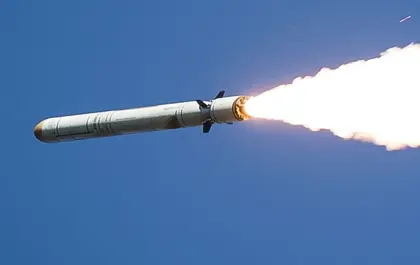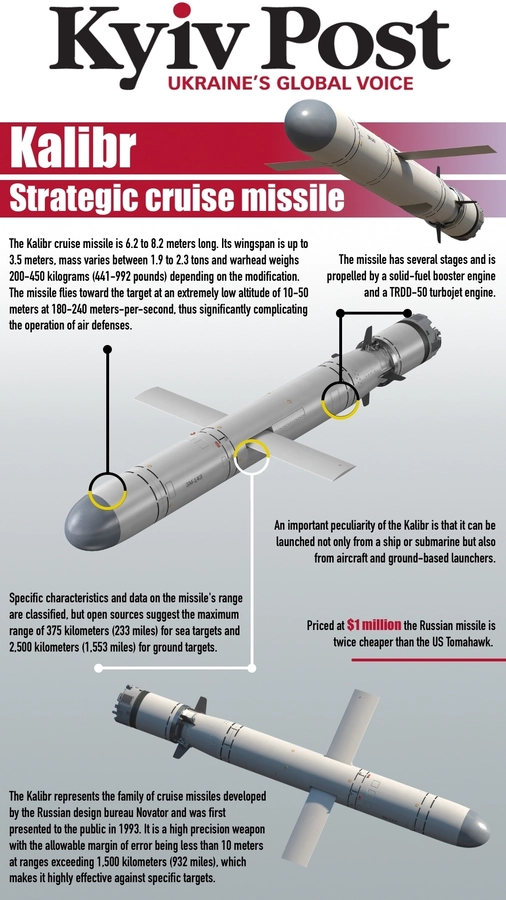Russia is targeting Ukraine with Kalibr missiles less frequently than last year, when it launched its full-scale invasion of Ukraine and fired them at Ukraine on an almost daily basis.
Let's take a closer look at what these missiles are and how the Armed Forces of Ukraine have gotten better at defending against them.
JOIN US ON TELEGRAM
Follow our coverage of the war on the @Kyivpost_official.
What is the Kalibr?
The Kalibr is a Russian sea-launched strategic cruise missile with a maximum range of 2,600 kilometers (1,616 miles), which covers all of Ukraine.
Missiles of this type are also used in the ground-based Iskander-K complexes, but their range is shorter – 500-2,350 kilometers (311-1,460 miles).
The Iskander-K complex can be armed with two types of missiles: R-500s and 9М729s. The latter visually resembles the sea-launched 3М-14 cruise missile – on the basis of which it was developed with minor design changes.
Infographics by Bohdan Tuzov
Russia violates international treaties
In 1987, the USSR and the US signed the Intermediate-Range Nuclear Forces (INF) Treaty, banning the manufacture, testing and deployment of all nuclear and conventional ground-launched ballistic missiles, cruise missiles and missile launchers with ranges of 500-1,000 kilometers (311-621 miles) and 1,000-5,500 kilometers (621-3,418 miles). The treaty did not apply to air or sea-launched missiles.
In breach of the treaty, which was not to expire until Aug. 2, 2019, Russia tested the 9М729 in 2017.

Zelensky Meets CIA Director William Burns in Ukraine
The Kalibr flies at 0.8 - 0.9 Mach (~1,000 kilometers-per-hour/ 621 miles-per-hour), which is below the speed of sound, but during the approach to the target it accelerates to the supersonic speed of 2.5 - 2.9 Mach (~3,000 kilometers-per-hour/1,864 miles per hour). That complicates its timely detection and interception by air defenses.
For missiles of this class, the allowable margin of error is normally 10 meters at the range of 1,500 kilometers, but specific information on precision is classified.
Another distinctive feature of the Kalibr is the low altitude: it approaches a ground target at 50-150 meters and a sea target at under 50 meters, which makes it more difficult for air defenses to detect and intercept.
The mass of the high explosive warhead is 450 kilograms (992 pounds), which is enough to totally destroy a small building.
According to tentative estimates, since its full-scale invasion, Russia has used about 250 Kalibr missiles, targeting Ukrainian apartment buildings, seaports, grain terminals and other civilian infrastructure facilities.
In the early months of the war, the successful interception rate was low, but the Ukrainian air defenses have since greatly improved both quantitatively and qualitatively.
For the majority of its flight, the Kalibr is radio-silent and autonomous. The wings enable it to effectively maneuver from one preprogrammed control point to another, so its flight trajectory is seldom straight. It also follows the terrain, maintaining an altitude and avoiding collision.
How to deal with the Kalibr
In a way, the Kalibr can be compared to a drone, but it flies very much faster and its destructive effect is very much greater.
Along with being able to fly at a low altitude, modern high-precision missiles such as the Kalibr can change their trajectory, altitude, and direction, further complicating the task for air defenses. Nevertheless, Ukraine has learned to cope with Kalibrs.
Thanks to Western partners' support and assistance, including the provision of NASAMS and IRIS-T systems, Ukraine’s air defenses have greatly improved and the interception rate has increased manifold.
During a Dec. 5, 2022 Russian missile strike, these systems liquidated 100 percent of the air targets, said Yuriy Ihnat, spokesman for the Ukrainian Air Force.
“All the targets were successfully shot down by NASAMS and IRIS-T systems. It's an impressive result. This 100 percent interception rate shows that Ukraine needs to completely rely on these modern weapons in the face of modern challenges and threats. So far, the backbone of our air defense consists of Soviet-era systems,” Ihnat added.
Since the Kalibr covers most of its distance at a subsonic speed, it can be shot down by a US Stinger hand-held launcher or its Soviet analog, Igla, whose missile flies at 750 meters-per-second (2,700 kilometers-per-hour / 1,678 miles-per-hour), or more than 2 Mach.
That’s enough to intercept a Kalibr. Ukraine already has battalions that specialize in intercepting these and similar missiles in areas where missile debris won’t harm people or infrastructure.
Another effective tool against Russian missiles is the mobile application ePPO (e-Air Defense), through which anyone can inform Ukraine’s air defense about missiles spotted or other potentially dangerous flying objects.
The information instantly reaches the military, facilitating their operation.
For example, on the morning of Oct. 22, 2022, about a dozen ePPO app users spotted a cruise missile following the terrain. It did not show up on radars, but geolocated marks instantly appeared on the maps of the air defense operators, giving them enough time to prepare.
As soon as the missile showed on the radar, it was locked onto and shot down.
Why are the Russians holding their Kalibr fire?
An important factor decreasing the number of missile strikes on Ukraine is the gradual depletion of Russian missile-launching capacities in the Black Sea and Crimea.
Following the destruction of the Moskva missile cruiser in April 2022, Ukraine did damage to the ships Novocherkassk, Tsezar Kunikov, Vasiliy Bekh and Vsevolod Bobrov.
In Oct. 2022, Ukraine struck the Russian naval base in Sevastopol, severely damaging the fast frigate Admiral Makarov that had regularly launched Kalibr missiles on Ukrainian cities, as well as several other warships – although the Kremlin reported “minimal losses.”
That same year, Ukraine also destroyed the big landing ship, Saratov, and a number of smaller landing ships and patrol boats.
Later, there were successful attacks on the reconnaissance ships Priazovye and Ivan Khurs and the patrol corvette Vasiliy Bykov. Another Ukrainian strike damaged the big landing ship Olenegorskiy Gornyak.
More recently, a Ukrainian missile strike on a dry dock in Sevastopol knocked out the big landing ship Minsk and the submarine Rostov-na-Donu (the latter is a Kalibr carrier). The fact was confirmed by the Ukrainian Defense Ministry's Main Intelligence Directorate.
In view of the Black Sea Fleet's shrinking capacity, Moscow decided to partly relocate to Novorossiysk.
Despite this depletion, Russia has plenty more Kalibr missiles.
While Russia targets Ukraine with Kalibr missiles less frequently, there’s a good chance it is storing them up for massive strikes in the cold season. Ukraine will urgently need more air defense complexes to protect its infrastructure.
You can also highlight the text and press Ctrl + Enter







